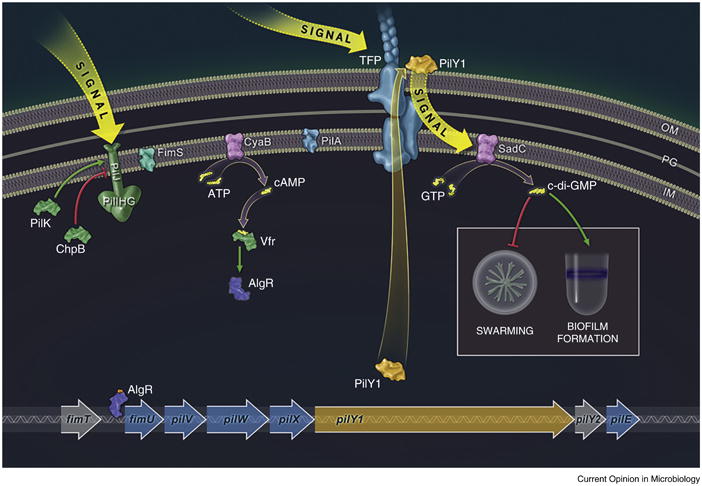Figure 2.

Surface sensing in Pseudomonas aeruginosa. A schematic model for cAMP and c-di-GMP signaling during early biofilm formation is shown. Subsequent to initial interaction with a surface, uncharacterized signals resulting from surface contact are detected by the chemotaxis-like protein PilJ and the type IV pilus (TFP), and transduced via the sensor histidine kinase FimS (also called AlgZ) and the adenylate cyclase CyaB, resulting in the surface-dependent increase in cAMP levels. PilK is the methyltransferase for PilJ, while ChpB serves as a demethylase; the methylation state of PilJ modulates its activity. cAMP, together with the transcription factor Vfr, are required for the transcription of the genes coding for FimS and its cognate response regulator AlgR. Phosphorylated AlgR is required for the increased transcription of several operons required for TFP biogenesis, including the fimUpilVpilXpilY1pilY2pilE operon. Thus, surface contact can establish a positive feedback loop whereby PilJ/TFP-mediated signals result in the increased production of TFP; TFP are in turn required for surface-associated twitching motility. Furthermore, as outlined in the text, bacterial two-hybrid studies indicate physical interactions between PilJ and FimS as well as between PilJ and PilA, suggesting that there may be an IM signaling complex required to sense and transduce surface signals. Subsequent to the stimulation of cAMP levels and transcriptional up-regulation of TFP-associated genes, the levels of PilY1 are increased. PilY1 is found on the bacterial cell surface and requires the TFP for its efficient secretion. Cell surface PilY1 can signal to SadC (by an unknown mechanism) to boost c-di-GMP levels, thereby repressing surface swarming motility and favoring the production of sessile cells and the formation of a biofilm. Additional details of this pathway can be found in Luo et al. [32••]. The WspR chemotaxis-like system controls later exopolysaccharide (EPS) production, also through the surface-dependent stimulation of c-di-GMP (not shown) [44–46].
Figure illustration and design copyright 2015 William Scavone and used with permission.
